Biz Lounge: From early retirement to financial freedom, growing grass
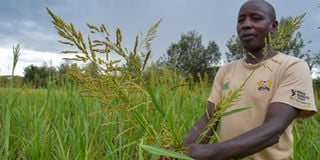
Waweru Nyangi showing an overgrown Columbus grass on March 19, 2025.
At the entrance to Waweru Nyangi's home in Kabarak, Rongai Sub-county, stands a large structure made of old tarpaulins.
One side of the building is completely covered, while the other is partially. Inside are bales of hay.
While many farmers are busy planting during the rainy season, Waweru's farm is relatively quiet. Instead Mr Waweru, a trained extension worker, cultivates various grasses on a 20-acre farm where he also keeps dairy cows.
He is part of a growing community of farmers who have switched from growing maize to growing grass due to the effects of climate change and low maize prices.
"I used to grow maize, but one day I had a full warehouse of maize, but the market price was so low that I had to sell some at Sh1,500 per sack and others even lower," he recalls.
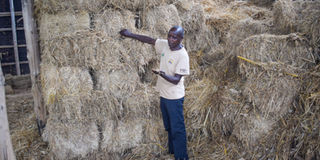
Waweru Nyangi in his hay store on March 19, 2025.
More than 20 years ago, Mr Waweru took early retirement to pursue farming, a decision he now considers the best he ever made.
"I took an early retirement, which was commonly called 'handshake retirement'. I felt I was wasting time and when the opportunity came, I took it. Now I don't even have time to rest because I'm always busy on the farm," he says.
When he started, Mr Waweru invested Sh70,000 in five acres of land, a much lower production cost compared to growing maize.
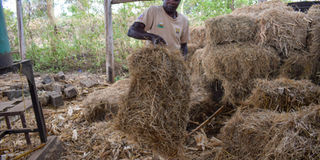
Waweru Nyangi carrying a bale of hay on March 19, 2025.
"Instead of maize, I decided to grow Boma Rhodes, Brachiaria grasses, Desmodium, Columbus, Lucerne and silage. These are high quality varieties that require little weeding, minimal pest control and are drought resistant," he explains.
Boma Rhodes takes 120 days to mature and yields between 150-200 bales per acre, while Brachiaria also takes 360 days to mature and produces between 200-250 bales per acre.
Mr Waweru faced a challenge when the market was flooded with farmers like himself. At one point, he was not making any money, so he built a warehouse and started keeping cattle to solve the problem.
"Before I built the store, I had the grass in the field, but no one would buy it. When it started to rain, I knew that no one would take wet hay. I decided that along with the shop I would buy cows to consume the fodder," he explains.
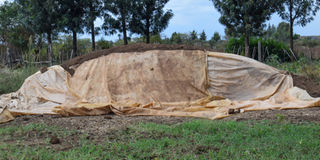
A silage reservoir at Waweru Nyangi's farm on March 19, 2025.
He produces fodder for his dairy cows and sells it, with hay fetching between Sh100 and Sh300 per bale and silage at Sh15 per kilo.
His success with forage production has inspired many local farmers and he plans to set up a forage demonstration farm to train others.
He hopes to encourage young people to explore fodder farming as a profitable business, stressing that agriculture has yet to be made attractive to the youth.
Mr Waweru is calling on the government to recognise fodder farming as a commercial venture and provide the same incentives given to other crops such as maize and potatoes.
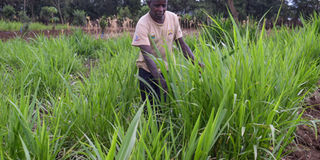
Waweru Nyangi inspecting nappier grass on March 19, 2025.
"Fodder farming has enormous potential to generate income for farmers, but the government has yet to recognise it as a commercial enterprise. Fodder farmers do not benefit from subsidised fertiliser, which would be a huge help if implemented," he argues.
The government, he says, can also set up collection points where farmers without storage facilities can store their hay, along with milling machines to add value during periods of surplus.


